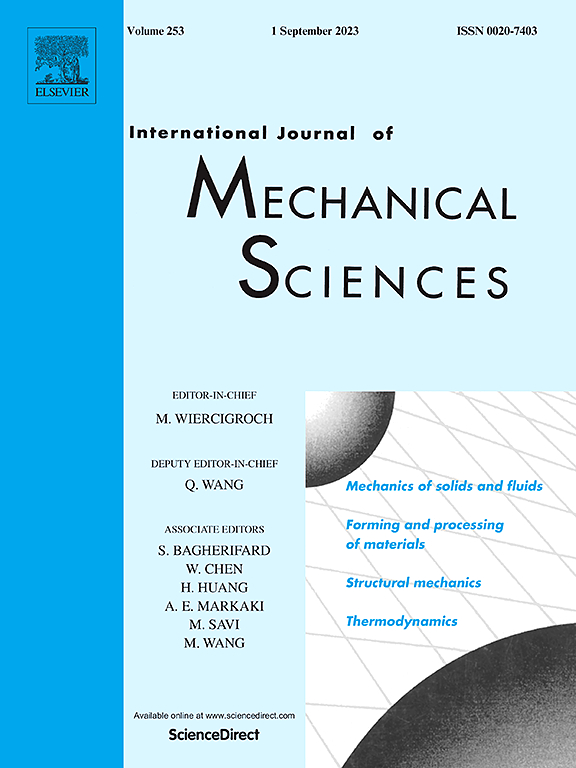多影响因素下磁流变阻尼器本构优化建模
IF 7.1
1区 工程技术
Q1 ENGINEERING, MECHANICAL
International Journal of Mechanical Sciences
Pub Date : 2025-04-17
DOI:10.1016/j.ijmecsci.2025.110284
引用次数: 0
摘要
多因素耦合下磁流变阻尼器(mrd)的准确本构建模是一个挑战,因为在多种影响因素下,实验成本和参数识别精度之间存在固有的权衡。为了解决这些限制,本研究提出了一种具有开创性的河马优化(HO)与Nelder-Mead Simplex (NMS)-Stacked Transformer (HNMS-ST)框架,该框架创新地集成了三个协同组件,以提高所提出的具有局部损失的bi塑- bingham (BB)模型的本构参数表征精度:(1)基于变压器的数据增强模型,补充合成训练数据,有效降低实验成本;(2)结合NMS策略和离群惩罚机制的约束HO,解决了BB模型在多因素耦合下参数辨识的不稳定性;(3)基于Transformer架构的动态参数映射模型,将优化后的本构参数与关键影响变量(包括有限元分析得出的磁感应强度和测量得到的温度)关联起来。大量的实验验证表明,与传统方法相比,HNMS-ST BB模型在多种影响因素下具有更高的预测精度和适应性。该方法解决了分段本构模型的参数表征难题,在降低实验成本的同时实现了MRD的高精度建模。本文章由计算机程序翻译,如有差异,请以英文原文为准。

Constitutive optimization modeling of magnetorheological dampers under multiple influencing factors
Accurate constitutive modeling of magnetorheological dampers (MRDs) under multi-factor coupling remains challenging due to the inherent trade-off between experimental cost and parameter identification accuracy under multiple influencing factors. To address these limitations, this study proposes a pioneering Hippopotamus Optimization (HO) with Nelder–Mead Simplex (NMS)-Stacked Transformer (HNMS-ST) framework, which innovatively integrates three synergistic components to enhance the precision in characterizing constitutive parameters of the proposed Biplastic–Bingham (BB) model with local loss: (1) a Transformer-based data enhancement model that replenishes synthetic training data, effectively reducing experimental costs; (2) a constrained HO combined with NMS strategy and outlier penalty mechanism, which resolves parameter identification instability in the BB model under multi-factor coupling; and (3) a dynamic parameter mapping model using Transformer architecture to correlate optimized constitutive parameters with key influencing variables, including magnetic induction derived from finite element analysis (FEA) and temperature obtained by measurement. Extensive experimental verifications underscore the superior predictive accuracy and adaptability of the HNMS-ST BB model under multiple influencing factors compared to traditional methods. The proposed method resolves the parameter characterization challenges of piecewise constitutive models, thereby enabling high-precision modeling of MRD while reducing experimental costs.
求助全文
通过发布文献求助,成功后即可免费获取论文全文。
去求助
来源期刊

International Journal of Mechanical Sciences
工程技术-工程:机械
CiteScore
12.80
自引率
17.80%
发文量
769
审稿时长
19 days
期刊介绍:
The International Journal of Mechanical Sciences (IJMS) serves as a global platform for the publication and dissemination of original research that contributes to a deeper scientific understanding of the fundamental disciplines within mechanical, civil, and material engineering.
The primary focus of IJMS is to showcase innovative and ground-breaking work that utilizes analytical and computational modeling techniques, such as Finite Element Method (FEM), Boundary Element Method (BEM), and mesh-free methods, among others. These modeling methods are applied to diverse fields including rigid-body mechanics (e.g., dynamics, vibration, stability), structural mechanics, metal forming, advanced materials (e.g., metals, composites, cellular, smart) behavior and applications, impact mechanics, strain localization, and other nonlinear effects (e.g., large deflections, plasticity, fracture).
Additionally, IJMS covers the realms of fluid mechanics (both external and internal flows), tribology, thermodynamics, and materials processing. These subjects collectively form the core of the journal's content.
In summary, IJMS provides a prestigious platform for researchers to present their original contributions, shedding light on analytical and computational modeling methods in various areas of mechanical engineering, as well as exploring the behavior and application of advanced materials, fluid mechanics, thermodynamics, and materials processing.
 求助内容:
求助内容: 应助结果提醒方式:
应助结果提醒方式:


